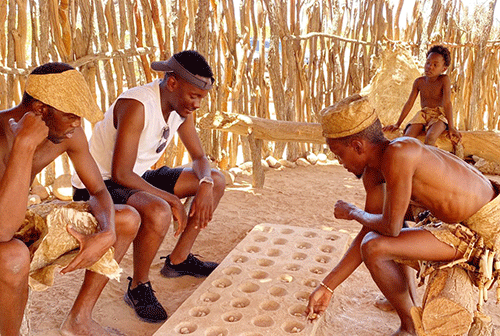Tuikila Kaiyamo
I had an unforgettable experience when I recently visited Damaraland, a region with the ancestry of the Damara clan. It was so fulfilling to pen down my experience and take you along this journey, once again.
The Damara Living Museum is a community project, situated about 10km north of the famous Twyfelfontein rock engravings site directly at the D2612. It is at the tip of the Twyfelfontein Lodge, and an hour’s drive from Khorixas.
This place will give you imaginary footage of the way of life, which I would describe as semi-nomadic and pragmatic, exactly as they lived several decades ago.
My friends and I embarked on a recreational visit to Uis, Khorixas, and Damaraland, of which the highlight was the visit to the Damara Living Museum.
The visit to the museum stems from the curiosity and eagerness to experience the rich culture and traditions of the different tribes that our country is blessed with. What made this tour unique was having a real-life demonstration of the different cultural practices as per the ancient times and how the elders lived. As a historian, the tour feeds one’s mind and soul with an enriching educative journey of our fellow countrymen and how they lived.
The journey from Windhoek and Swakopmund takes about five hours, of which a large portion is on gravel. Upon our arrival, we were welcomed by a gentleman called Immanuel, who expressed joy in receiving visitors from a different tribe or a different country, which excites them as they become energetic to teach visitors their way of life.
The tour was carved into different parts where we learned about the different plants used as remedies for various illnesses. The ancient household would consist of a mine pharmacy.
We learned how to make fire from different plant weeds, and of course, most of us struggled as we are used to modern ways of using matchbox and Blitz. They further showed us how to carve different weapons.
This trip would not have been worthwhile if we had not experienced leisure in the form of traditional dancing, which we saw firsthand.
We were exposed to the exact dress attire, and huts, which are very familiar to that of the Aawambo and Ovahimba tribes, especially in ancient times.
Medicine and healing
What was most shocking, or rather surprising, was the different plants that they used as medication. Particularly on how they discovered which plant is for which illness. I asked how they knew which plant proved to be a remedy for different illnesses. They informed me that they had trials and errors with different plants to see which would make one vomit, and feel feverish; in fact, even if it meant one would die.
Another surprising factor is also how the inhabitants from different areas, in case of a disagreement or a dispute, would not go into a physical fight or violent altercation, but rather a battle of a ground board game, like the “Owela’ of the Aawambo tribe.
The tour lasted about two hours, all worth it. One hour is for the tour of the household, whereas a tour in the wilderness to learn about hunting experiences is an extra hour.
The biggest lesson that I learned is that even though their population is small, it does not mean that their history isn’t rich. They made the most from the little they had and without the modern-day technology and access to basic needs.
It is essential that as Namibians, we do not enclose ourselves in our own cultures where we may come from but open our minds and learn from other cultures to appreciate tolerance and appreciate the diversity that we always preach in our society. It is a practical task that is entirely worth it.
* Tuikila Kaiyamo is an avid
traveler.


